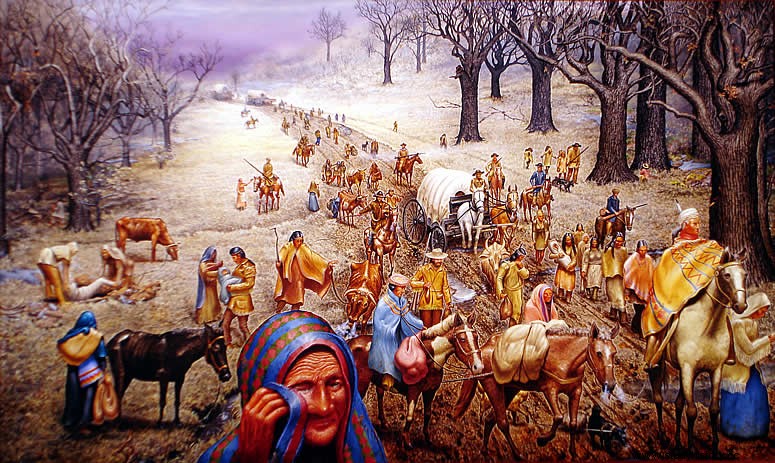The Choctaws , a Native American people located in the southeastern United States in present-day Mississippi Territory, were the first people to experience forced removal, dressed in friendly agreement, to Indian reservations. In 1830, the US Congress passed the Treaty of Dancing Rabbit Creek , a personal project of the president of the USA, Andrew Jackson , which consisted of the transfer of 11 million acres (45,000 km 2 ) from the Choctaw Nation in exchange for some 15 million acres (61,000 km 2 ) in the territory of present-day Oklahoma. At first the Choctaw chiefs were reluctant to leave their ancestors' lands, but in the end they had to give in. Still, they managed to include a clause…
Each Choctaw head of household who wishes to remain in their territories and become a citizen of the United States shall be permitted to do so…shall be entitled to the reservation of six hundred and forty acres of land…
The Choctaw became two distinct groups:the nation in Oklahoma (they kept some autonomy and continued to regulate themselves with their own rules and traditions) and the Mississippi tribe (subject to the laws of the US government). In this way, the part of the Choctaw who remained in Mississippi became the first non-European ethnic group to obtain US citizenship. Some 1,300 Chochtaw chose the latter option and some 15,000 started the so-called Trail of Tears (Camino de Lágrimas), a march of more than 800 km in which almost 20% of them died of hunger.

The Trail of Tears
In 1845, 5,000 km away, the Great Irish Famine occurred. . The inefficient economic policy, the inadequate methods of cultivation and, above all, the appearance of certain diseases that destroyed the potato harvest, caused a great mortality among the Irish… between one and two million Irish people died of hunger. News of the famine reached the US and many Irish emigrants tried to help their countrymen. In 1847, 16 years after they themselves were victims of the famine, the Choctaw saw themselves reflected in that suffering and set an example of historic solidarity. They, who barely had enough to cover their needs and did not even know where to locate Ireland geographically, managed to raise 175 dollars (about 70,000 today) to help Irish families. The only thing both peoples had in common was hunger… and humanity.
This article is part of the Fundación Mutua Madrileña Solidarity Post Contest
